We guide you through all the ruins that can be visited near Pompeii.
Ruins near Pompeii
When Mount Vesuvius erupted in 79 AD, it didn’t just destroy Pompeii, it preserved an entire region in volcanic ash and mud. While Pompeii gets all the fame, you’re missing out if you skip the other archaeological sites scattered around the Bay of Naples, each telling a different part of this ancient tragedy.
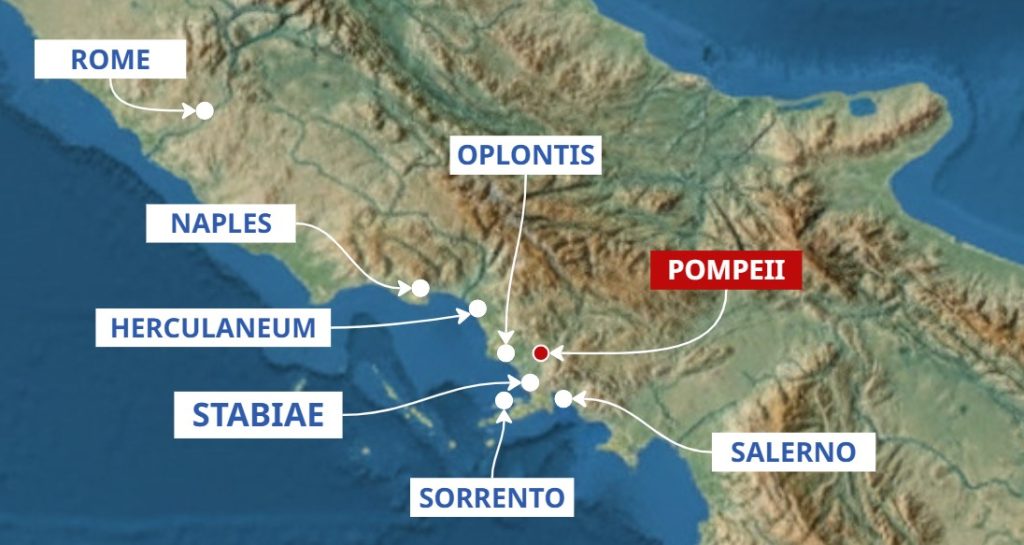
Herculaneum often plays second fiddle to its famous neighbor, and that’s exactly what makes it special. While Pompeii attracts millions of tourists annually, Herculaneum offers something different, namely an intimate encounter with Roman life that is almost voyeuristic in its detail.
And let’s be honest, Herculaneum is actually better preserved than Pompeii.
Why aren’t more people talking about this place? For centuries, archaeologists believed Herculaneum’s residents had successfully escaped the eruption because so few bodies were found in the excavated town. That theory held until 1982, when excavators reached the ancient shoreline and discovered more than 300 skeletons huddled inside the stone boathouses. These people had fled to the waterfront, desperately hoping for evacuation by sea. They never made it.
Here’s what really sets these sites apart: they died differently. Pompeii was buried under a relentless rain of volcanic ash and pumice that lasted for hours. The weight (up to 5 meters deep) crushed roofs and allowed water and air to seep in over centuries, rotting away organic materials. That’s why you see those famous plaster casts in Pompeii, because the bodies decomposed, leaving cavities that archaeologists later filled with plaster.
Herculaneum? That’s a completely different story. Being closer to Vesuvius, it was hit by pyroclastic surges, superheated avalanches of gas and volcanic mud moving at temperatures of 400-500°C. This intense heat didn’t burn the organic materials with oxygen; it instantly carbonized them, turning everything into charcoal. The mud then hardened like rock, creating an airtight seal.
What does this mean for you as a visitor? In Herculaneum, you’ll see actual wooden beams, doors, beds, and staircases, carbonized but intact. You’ll walk through multi-story buildings with their original wooden balconies still in place. The colors in the frescoes are so vivid they look freshly painted. Even food survived. Carbonized bread, figs, and nuts sit in display cases, looking eerily edible after two millennia.
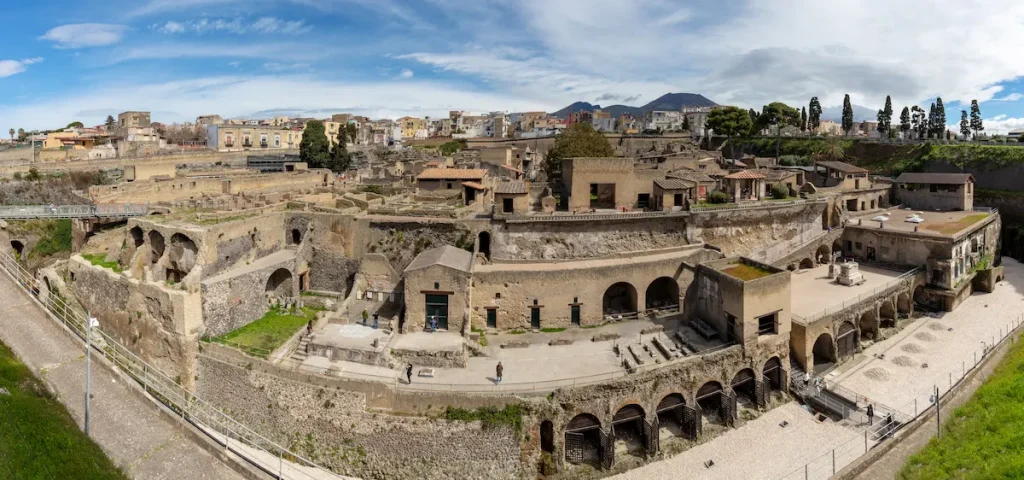
To be honest, fame doesn’t equal preservation quality. Pompeii covers 150 acres of excavated area, it’s a complete Roman city with forums, amphitheaters, and wide streets. But in Herculaneum only 20 acres have been excavated, making it feel more like a wealthy seaside neighborhood than a metropolis.
Then there’s the discovery story. Herculaneum was actually found first, in 1709, but it was buried under more than 20 meters of solid volcanic rock. Early excavation required tunneling by torchlight, an incredibly difficult and often destructive process. Pompeii, discovered later in 1748, lay under a much shallower layer of soft ash and pumice. It was easier to excavate and reveal to the world.
But the real reason for Pompeii’s iconic status came in the 19th century: the plaster casts. When archaeologists developed the technique of filling the body cavities with plaster, they created a visual representation of the tragedy that was morbidly fascinating and utterly unique. Those frozen figures became the “logo” of the Vesuvius eruption, capturing imaginations worldwide. Herculaneum’s skeletons, as scientifically valuable as they are, simply don’t have the same visceral impact.
Think of it this way: Pompeii shows you how Romans lived publicly; Herculaneum shows you how they lived privately.
Choose Pompeii if you want to understand the scale of Roman civic life. You need at least 4-6 hours to scratch the surface. It’s where you’ll walk through a vast forum, stand in an amphitheater, and feel the layout of an ancient metropolis.
Choose Herculaneum if you’re fascinated by intimate details, original furniture, intact upper floors, and preservation that borders on miraculous. You can see it thoroughly in 2-3 hours, and you’ll often find yourself alone in entire houses. Plus, there’s actual shade here, unlike Pompeii’s sun-baked ruins.
Have enough time? Visit both. They’re complementary pieces of the same tragic puzzle.
The first thing you should see are the Termal Baths, which tell a story about Roman social life and gender segregation. The men’s section was larger and more luxurious, with a complete sequence of rooms ranging from cold to hot. The women’s section, smaller and less decorated, notably lacked a cold bath. Don’t miss the mosaic floor in the women’s changing room, a stunning depiction of Triton surrounded by sea creatures. You can still see the terracotta pipes in the walls that circulated hot air for the underfloor heating system.
On the other hand, we have the House of Neptune and Amphitrite, which belonged to a wealthy merchant. The shop window, a thermopolium or ancient fast food counter, still has wine jugs lined up on the counter. But the most striking feature is the mosaic on the wall of the summer dining room, made not only of stone but also of glass paste that still glows with bright blue and green hues after 2,000 years.
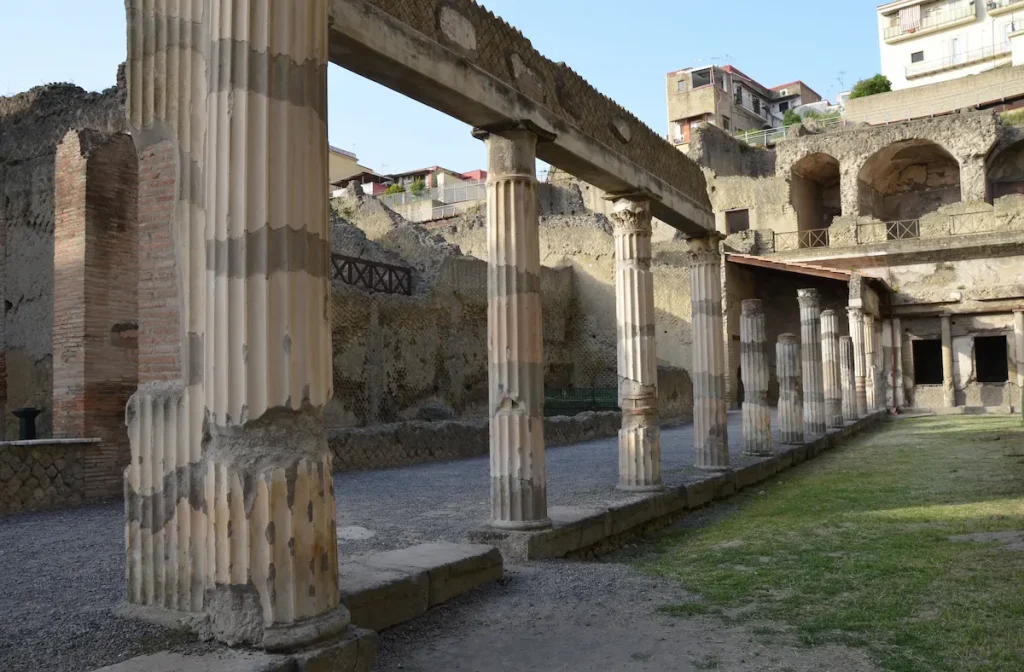
The House of the Wooden Partition preserves something not seen anywhere else: a charred wooden partition that slides on bronze rails. Think of it as the Roman equivalent of a Japanese shoji screen. In Pompeii, this would have rotted away centuries ago.
Finally, there are the Boathouses. These hold the most tragic story of Herculaneum. For years, archaeologists thought that the population had escaped. Then in 1982, they found over 300 skeletons huddled in the beach’s stone boat sheds, waiting desperately for rescue by sea. Forensic analysis reveals they died instantly from thermal shock—the heat vaporized their soft tissues and literally made their skulls explode. Among them: a woman clutching her jewelry, a soldier with his sword, and a mother cradling her child.
Oplontis isn’t a city but the name of an ancient residential area. The main site here is Villa A, popularly known as Villa Poppaea. This isn’t a townhouse but a maritime luxury villa on a truly imperial scale, one of the most sumptuous in the entire Roman world.
The central narrative of this villa is its connection to Poppaea Sabina, Emperor Nero’s second wife. While the evidence is circumstantial, it’s compelling. A painted inscription on an amphora (transport jar) found at the site referenced Secundus, a slave or freedman of Poppaea. The sheer opulence of the place, like the use of solid marble columns instead of cheaper painted stucco, strongly suggests imperial ownership. Legal documents discovered in Herculaneum confirm that Poppaea’s family owned businesses (like tile factories) in this area.
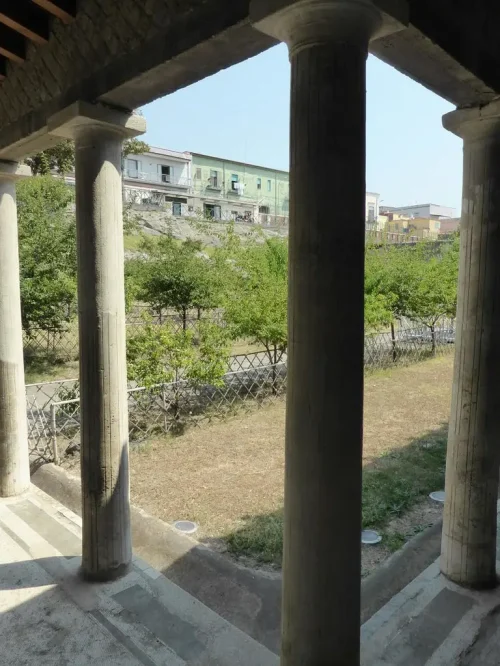
Take the same Circumvesuviana train from Naples toward Sorrento, but get off at “Torre Annunziata – Oplonti” station. The villa entrance is literally steps from the platform.
The atmosphere here is dramatically different, you might have the entire villa to yourself. Perfect for art lovers and anyone seeking quiet contemplation away from the tourist hordes.
Absolutely, but for a specific purpose. If Pompeii is the city and Herculaneum is the home, Oplontis is the palace. It’s worth visiting for anyone interested in Roman art and experiencing a glimpse of imperial elite luxury that the other sites can’t match.
Stabiae, located in the modern city of Castellammare di Stabia, was an exclusive residential resort. This is where Rome’s elite (senators, generals) built their villae otium (leisure villas), places designed for escaping the political pressures of Rome.
The villas weren’t built on flat land but high on a 50-meter cliff overlooking the Bay of Naples. Why? The view. These panoramic vistas of the bay and Vesuvius were the whole point. The Romans called these “villae otium“, leisure villas designed purely for relaxation and showing off.
Two main villas are open to visitors: Villa Arianna (named for a large mythological fresco of Ariadne) and Villa San Marco (one of the largest Roman residential villas ever found at over 11,000 square meters).
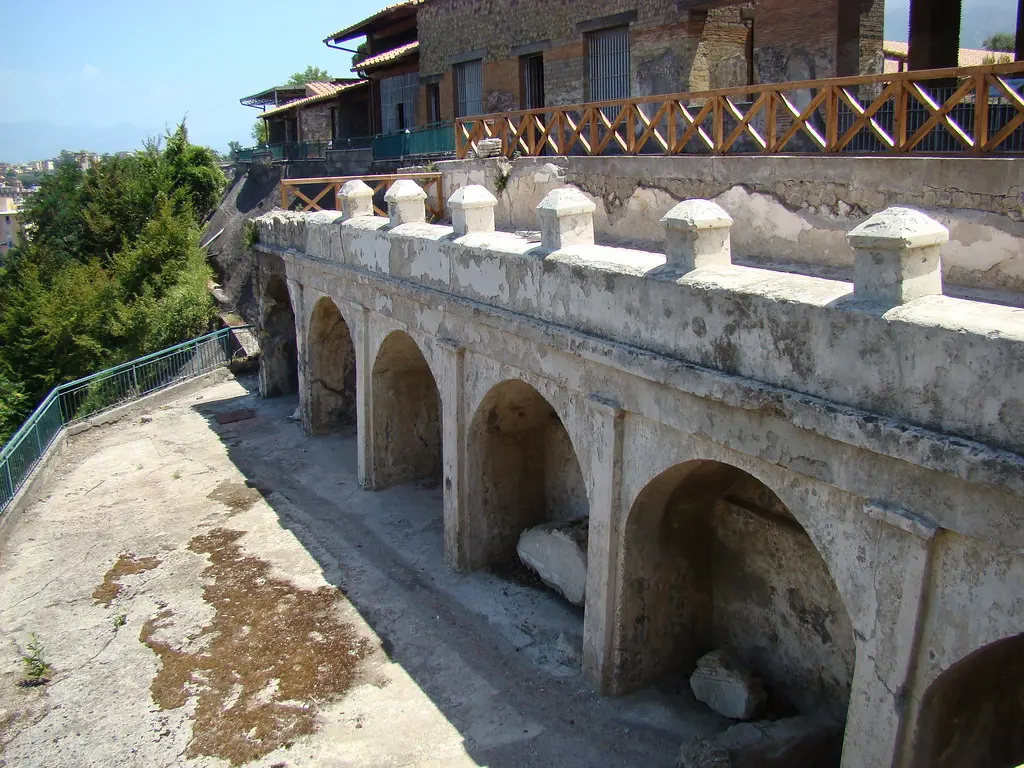
The atmosphere at Stabiae is completely unique. It’s spacious, panoramic, and remarkably peaceful. It doesn’t feel like an urban excavation but rather like strolling through a series of luxury country estates. Parts of these villas are still being actively excavated, giving you a sense of ongoing discovery.
Yes, and this is one of the best values in the region: Entry to Villa Arianna and Villa San Marco is completely FREE.
Take the Circumvesuviana line (Naples-Sorrento) to “Via Nocera” stop. From the station, it’s either an uphill walk or a short ride on a local bus.
If Stabiae was about leisure, Boscoreale was all business. Located just north of Pompeii, this agricultural belt was famous for its vineyards, and it still is today.
The main site is Villa Regina, not a palace but a working farm dedicated entirely to wine production. The wine press room (torcularium) and wine cellar (cella vinaria) are perfectly preserved. The cellar contains 18 enormous terracotta jars (dolia) buried in the ground where grape must fermented and aged. In an amazing bit of experimental archaeology, scientists found root casts from the original 79 AD vines and replanted the vineyard exactly as it was, using the same grape varieties.
The real treasure is Boscoreale’s Antiquarium museum, focusing on daily life and agriculture.
Boscoreale has its own Circumvesuviana stop: “Villa Regina-Antiquarium”. The site is right outside the station, couldn’t be easier.
The 79 AD eruption unfolded in two distinct phases. These two phases explain all the differential preservation observed at the sites.
Day 1, around 1:00 PM: Vesuvius erupts. A colossal column of gas, ash, and pumice (lapilli) shoots more than 20 miles (32 km) high, looking like a “pine tree,” as described by eyewitness Pliny the Younger.
Day 1, Afternoon/Night (18-20 hours): Prevailing winds blow the eruptive column southeast. This column begins “raining” its contents. Pompeii and Stabiae (both southeast) are covered by a constant rain of light pumice and ash lasting for hours. This accumulates up to 5 meters deep. It’s not instantly lethal, and people have time to flee. The main danger comes from roof collapses under the weight of accumulated ash.
Herculaneum’s fate? Being located to the west, it was upwind of the ash cloud. It received almost nothing from this initial rainfall.
Day 2, around 1:00 AM: The eruptive column, having lost pressure, collapses under its own weight.
Surge 1 (around 1:00 AM): An avalanche of superheated gas and ash (400-500°C) descends the slope at more than 100 km/h. Being closer and in the direct line of fire, it crashes into Herculaneum. Impact: Instant death by thermal shock for everyone remaining (including the 300+ in the boathouses). The flow fills the city, carbonizes it, and seals it hermetically in mud that hardens like rock.
Surges 2-6 (around 1:00 AM – 8:00 AM): Multiple more surges follow. Impact on Pompeii: The later surges (Surges 3-6), now cooler but still lethal, finally jump Pompeii’s walls on the morning of Day 2. They kill those who remained, most likely through asphyxiation from toxic gases and fine ash, as well as from heat.
POMPEII TICKETS
TOURIST INFORMATION
POMPEII INFORMATION
